Itinerary: Backpacking the Trans-Catalina Trail
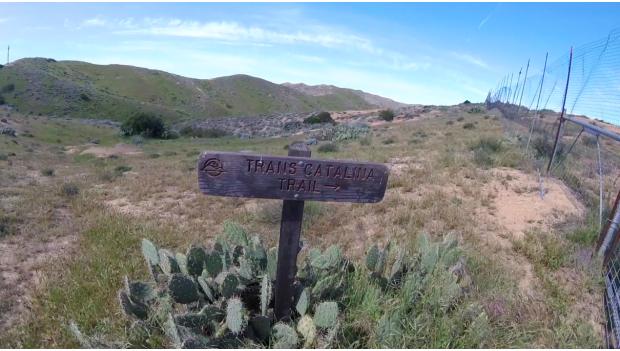 Stretching from Avalon on the east end of Catalina Island to Parsons Landing on the west side, the Trans-Catalina Trail is one of the most unique and beautiful multi-day hikes in the world. Located 22 miles off the coast of California, the island boasts a 42,000-acre Nature Preserve packed with native flora and fauna, and unforgettable terrain. Don’t mistake its beauty for ease though, with almost 10,000 feet of total elevation gain it’s a difficult hike for even the most accomplished backpackers.
Stretching from Avalon on the east end of Catalina Island to Parsons Landing on the west side, the Trans-Catalina Trail is one of the most unique and beautiful multi-day hikes in the world. Located 22 miles off the coast of California, the island boasts a 42,000-acre Nature Preserve packed with native flora and fauna, and unforgettable terrain. Don’t mistake its beauty for ease though, with almost 10,000 feet of total elevation gain it’s a difficult hike for even the most accomplished backpackers.
While it’s possible for ambitious backpackers to tackle the trail in about four days, my partner and I spent one full week on the island, exploring everything Catalina has to offer.
After all, it’s called island time for a reason.
Here’s everything you need to know about hiking the Trans-Catalina Trail.
Permits: Like most popular destinations, hiking permits are required for the Trans-Catalina Trail. Permits are free and can be obtained at the Nature Center at Avalon Canyon, the Airport in the Sky, the Two Harbors Visitor Information Center and the Conservancy House in Avalon. We went with the latter, as the Conservancy House is just a short walk up the road from downtown Avalon. There was no hassle, and we were in and out with permits in less than 15 minutes. Be aware these are permits just for hiking access; read below for information on camping reservations.
Camping: Reservations can be made with Reserve America and through the Santa Catalina Island Company Visitor Services website. Note the campsites featured in our itinerary below aren’t all found on the “Primitive Camping” page. Some campsites will be found in the “Avalon Camping” and “Two Harbors Camping” pages, on the right rail of the page. If you need help, call Visitor Services at (310) 510-4205.
How to Get There: It’s surprisingly easy to get from the California mainland to Catalina Island. The most common mode of transportation is the ferry. The Catalina Express cruises for roughly one hour, and departs multiple times every day from San Pedro, Dana Point and Long Beach to the port in Avalon. Other smaller companies offer private ferry service, and you can even take a helicopter or small plane if you’re feeling more adventurous (or willing to spend more money).
Itinerary: One Perfect Week Backpacking the Trans-Catalina Trail
Like mentioned before, we decided to make a full week of the Trans-Catalina Trail. Neither of us had trained especially hard for the excursion, but we live active lifestyles so we were in decent shape. After arriving in Avalon via the Catalina Express ferry from San Pedro, we set off on our great adventure. The challenge: backpacking 47 miles with about 9,600 feet in elevation gain.
Here is a day-by-day itinerary of our perfect week on the Trans-Catalina Trail.
Day 1: 0.5 miles
Avalon to Hermit Gulch
After disembarking from the boat and picking up your permits, this is a quick walk up the road from the harbor to the popular Hermit Gulch Campground. It has running water and full showers, but the island is experiencing a serious drought so they restrict water usage. Fuel up at The Sandtrap, a small Mexican restaurant along the way, serving dollar tacos and cheap beer.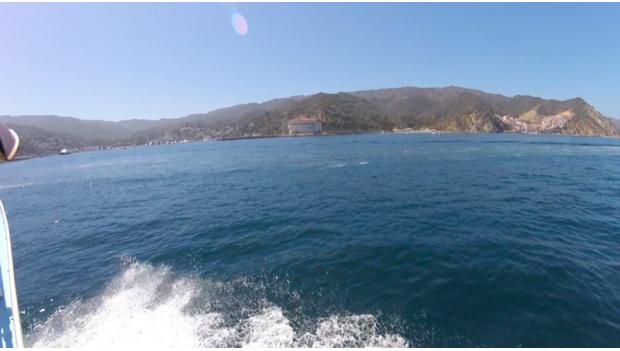
Day 2: 10 miles
Hermit Gulch to Black Jack
At the time of our visit, the beginning (southernmost) portion of the trail was under maintenance, so we decided to leave straight from the Hermit Gulch Campground. It’s a steep walk up to Divide Road, but the scenic views of Avalon are worth the effort. If you’re lucky, you’ll see the wild herds of bison roaming through the hills. At the end of day two’s journey, Black Jack Campground is waiting with wooden picnic tables, fire pits, tire swings and fresh water.
Day 3: 7.2 miles
Black Jack to Little Harbor
From Black Jack we headed up and over the middle of the island to the Little Harbor Campground on the western shore, with a quick stop at the Airport in the Sky for a much needed bison burger and iced tea at DC-3 Gifts and Grill. By this point, the weather was warming up, and we were glad we packed sunscreen and UV protective clothing. Even though the trail is coastal, it was surprisingly hot near the center of the island. Little Harbor had a quaint protected cove perfect for cooling off after a long day. Fresh water and chemical toilets are available for campers.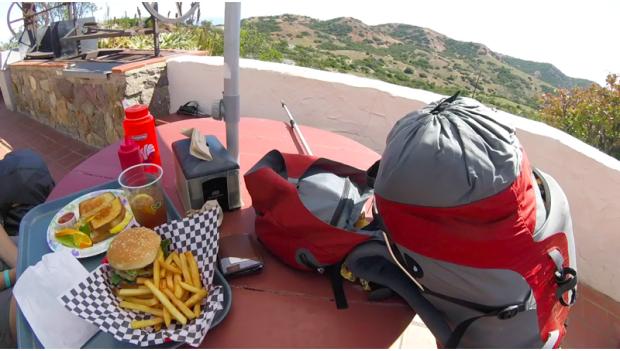
Related: Ultimate Guide to Camping in California
Day 4: 5.5 miles
Little Harbor to Two Harbors
Continuing the trend of climbing and descending, we then made our way from Little Harbor back across to the east side of the island to Two Harbors. While it was the shortest distance of the hiking days, we found it to be one of the most strenuous. After settling in at Two Harbors Campground, we rented a kayak and explored the many little coves along the coastline before finding dinner in town. Fresh water, showers and chemical toilets are available at the campground.
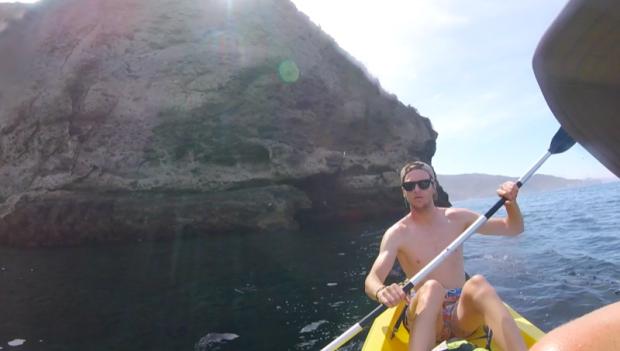
Day 5: 6.7 miles
Two Harbors to Parsons Landing
The majority of the leg from Two Harbors to Parsons Landing took place on a fire road following the Silver Peak Trail (1,600 feet of climbing). Be careful on the descent back down to Parsons Landing – it’s very steep and covered in loose gravel. With all the climbing and descending, hiking poles are definitely advised for this entire trip. The Parsons Landing Campground sites are right on the sand, and this was easily our favorite spot of the entire trip. The beach camping experience felt remote and relaxing. Chemical toilets are available, and a gallon of water is included with your site.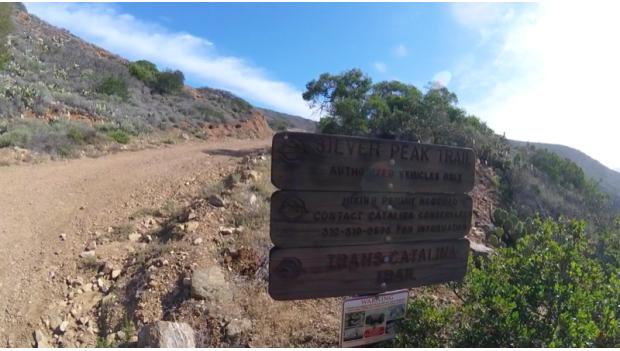
Day 6: 9.5 miles
Parsons Landing to Starlight Beach to Parsons Landing
The hike from Parsons Landing to Starlight Beach is the reward for completing the previous days’ challenging hikes. Leave all your tent and gear at the campsite, gather up a small day pack and head out on the 4.7-mile out-and-back trail. It rained on us at this point, so be sure to carry a lightweight rain shell as island conditions can change rapidly. As with the trail in its entirety, the total elevation gain can sneak up on you, despite the only 600-foot max distance.
Day 7: 7 miles
Parsons Landing to Two Harbors
Instead of heading back up and over the Silver Peak Trail, we took the flatter and easier coastal trail back to Two Harbors. It featured rolling hills instead of big ascents, and it was nice seeing all the coves along the eastern side of the island. Don’t forget, if you follow this recommendation, you need to make your return reservations with the Catalina Express ferry from the Two Harbors port, not the Avalon port. Currently, Two Harbors port only returns to the San Pedro port on the mainland, so keep this in mind before you depart (as you don’t want to leave your car stranded at a different California port).
If preferred, you can also book a ticket with the Safari Bus to shuttle you back from Two Harbors to the city of Avalon, to return to your mainland port of choice.
Tips for Backpacking the Trans-Catalina Trail
1. Be on the lookout for wildlife. We saw bison, stingrays, an island fox and several species of shorebirds.
2. Hiking poles are strongly advised. Not only did they help shoulder the load when climbing, they also added stability and took pressure off our knees on the descents.
3. Find boots that fit you. Make sure you have plenty of room in the toe box – all of the descending treks push the foot forward in the boot and can make for an uncomfortable experience (cough, lose a toenail, cough).
4. Don’t forget sunscreen and lightweight protective gear. Although it was relatively mild for us, the conditions can change rapidly. Check the weather before you head out.
5. Grab an area map when you pick up your permits. The trail is pretty straightforward, but carrying a map is always a great idea.
6. Bring a battery charger with you. The majority of the trail has cell service.
7. Carry cash with you to purchase supplies at the Airport in the Sky or Two Harbors.
Also Read: Top 10 Reasons Why Everyone Should Try Backpacking

